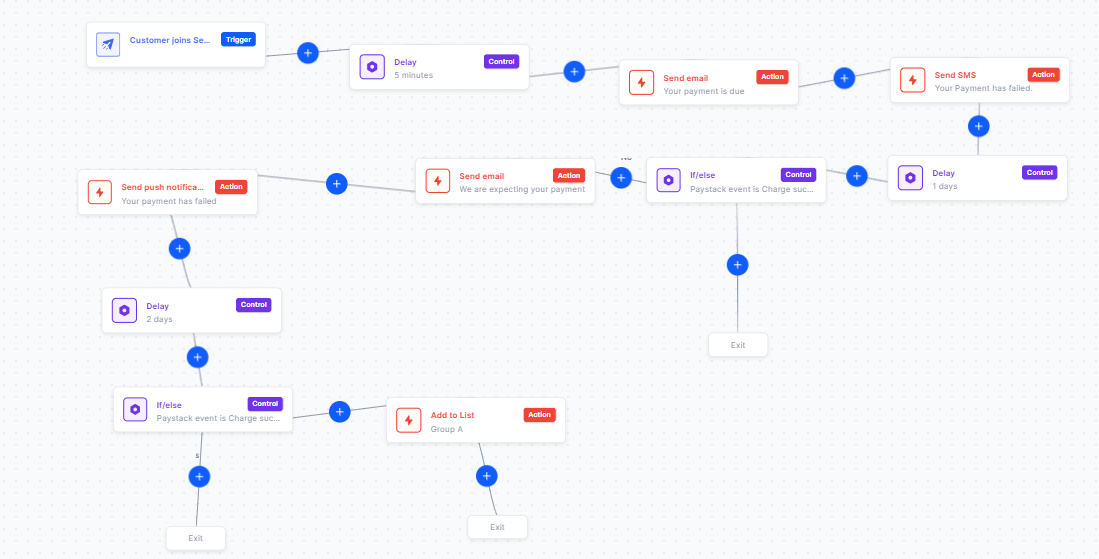Marketing Automation Strategy For SaaS Companies
Marketing automation has led to wins for companies that used them right, from more leads, to increase conversions and sales, all with less work.

The invention of marketing automation has led to wins for companies that used them right, from more leads, to increase conversions and sales, all with less work.
For marketing professionals, marketing automation helps to increase work efficiency, reduce cost and improve customer experience.
It can be difficult to get started with marketing automation but with the right strategy and tools,
it’s easier than you think. Get it right and it will offer great rewards, too.
In this article, we’ll be discussing everything you need to get started with marketing automation and how you can use it to your advantage.
- What is marketing automation?
- Importance of marketing automation strategy important for SaaS
- Steps to create a marketing automation strategy
- Marketing automation strategy examples
- Conclusion
Let’s dive in
What is marketing automation?
Marketing automation refers to the use of software and technology by product marketers to automate repetitive marketing tasks and workflows across different channels.
Marketing automation allows marketers to streamline their marketing processes and deliver personalized, targeted messages to their audience at scale.
It enables marketers to automate various aspects of their marketing efforts, such as email campaigns, social media posting, lead nurturing, customer segmentation, and data analysis.
With marketing automation, marketers can create and schedule marketing campaigns, set up campaign triggers based on customer actions or behaviors, and track and analyze their campaign performance, all from a single platform.
This technology leverages customer data and behavior to deliver relevant and timely messages to the right audience, improving engagement, lead generation, and customer retention.
Importance of marketing automation strategy important for SaaS
SaaS Customers and users are constantly seeking answers to questions relating to the product, they want answers and to get their issues resolved as soon as possible, if possible without reaching out the support.
.With marketing automation your users can get their answers in a contextual and timely way.
Aside from this, some important repetitive tasks and activities are hard to accomplish without automating them.
For example, sending a confirmation email to every new signup on your platform can be difficult to accomplish with automation.
There will be delays and errors if the process is not automated.
With marketing automation, You can eliminate human errors and increase consistent personalized experiences for all your users in a cost effect manner.
Steps to create a marketing automation strategy
Now that you’ve understood what marketing automation is and why is it important for your SaaS business, let’s see what are steps taken to create a marketing automation strategy.
There are several steps you need to take when creating a marketing automation strategy
1. Define Your Marketing Automation Goals
Your first task in creating your strategy is by setting clear and specific marketing goals that align with your overall business objectives.
You need to Identify what you want to achieve with marketing automation, whether is it lead generation, customer retention, or you want to improve customer engagement.
2. Understand Your Audience
To understand your audience, you will need to conduct thorough market research about your target audience's needs, preferences, and pain points.
Create buyer personas to segment your audience and tailor marketing messages accordingly.
3. Map Out Your Customer Journey
Next is to develop a comprehensive customer journey map that clearly outlines your customer touchpoints and interactions across different stages of the buyer's journey. Identify opportunities to engage prospects and customers effectively.
4. Identify those tasks that need to be automated at each stage of the customer journey
Check for tasks that are repetitive in each stage of the customer journey that can affect your conversion rate.
You should know you can only get the best out of marketing automation if you apply it the right way.
So, it’s important to clarify what tasks are needed to be automated. Here are a few good examples of tasks that can and should be automated:
- Sending a welcome email when a new user signs up on your platform
- Sending a message when a user hits a milestone on your platform e;g completes a course or task.
- Confirm subscription renewal
5. Choose the Right Marketing Automation Platform
Marketing automation can be achieved without having the right platform, you need to select a marketing automation platform that aligns with your needs and budget.
Check out the different platforms based on their features, scalability, ease of use, and integration capabilities with your existing tools.
6. Monitor Compliance and Data Security
You have to ensure that your marketing automation strategy put data security into consideration. You must comply with data protection regulations and follows best practices for data security because your customers trust you with their data, so maintaining their privacy is crucial.
7. Create, Test, and Optimize
Create your automation workflows based on customer actions and behaviors. These workflows can include user onboarding campaigns, lead nurturing campaigns, or post-purchase follow-ups.
After launching each campaign, you need to continuously monitor and analyze the performance of your marketing automation campaigns.
A/B tests different elements to identify what works best and optimize your strategy accordingly.
Marketing automation strategy examples
Different tools on your preferred marketing automation will serve different purposes, for example, You will use the tools in your marketing automation stack for multiple purposes.
A landing page builder will be used to design and build landing pages for lead acquisition
This is why it is important that knowing what to automate is essential in a marketing automation strategy.
Now that we covered the steps to creating a marketing automation strategy, let’s look at some examples of what can be automated at each stage in the user journey.
Awareness/ Acquisition Stage
The awareness stage is that early stage where users are just getting to know about your business it comes before user acquisition, while the acquisition stage is that stage where users have decided to try out your product (signing up for a free trial or freemium account).
Example of automatons you can implement in the acquisition stage
- Content Drip Campaign: You Implement an automated email series that delivers valuable educational content to prospects who have recently subscribed to your newsletter or visited your website.
Consideration Stage
During this stage, prospects have shown interest in your products or services and are actively evaluating different options. Your marketing automation strategy at this stage should focus on providing valuable information,
Example of automatons you can implement in the Consideration stage
- Lead Nurturing Workflows: You will need to set up automated workflows that will deliver targeted and personalized content based on the prospect's interests and behavior. This could include sending case studies, product comparison guides, or demo invitations.
Decision/Adoption Stage
During the Decision/Adoption Stage of the customer journey, prospects have narrowed down their options and are ready to make a purchase decision. They may be considering signing up for your paid plan, subscribing to your service, or committing to a long-term contract.
Example of automatons you can implement in the Decision/Adoption Stage stage
Automated Product Demos: Offer automated product demos that prospects can schedule at their convenience, showcasing the value of your product and helping them make an informed decision.
- Abandoned Trial Recovery: Implement automated emails to follow up with prospects who abandoned a free trial, offering additional support or incentives to encourage them to sign up.
Purchase Stage
During the Purchase Stage of the customer journey, your prospects have decided to buy and are ready to complete the transaction.
At this stage, your marketing automation strategy should focus on providing a seamless and personalized purchasing experience that encourages your users to follow through with their decision.
Example of automatons you can implement in the Purchase Stage Stage
- Automated Welcome Emails: Send personalized welcome emails to new customers, thanking them for their purchase and providing order confirmation details.

- Upsell/Cross-Sell Campaigns: Utilize marketing automation to identify upselling or cross-selling opportunities based on the customer's purchase history, and send relevant offers to maximize customer value.
Post-Purchase Stage
At this stage of the customer journey, you should focus on shifts from acquisition to customer retention and fostering long-term customer loyalty.
Your marketing automation strategy should focus on providing excellent customer support, encouraging repeat purchases, and building a strong relationship with your customers.
Example of automatons you can implement in the Post-Purchase Stage
- Automated Onboarding Series: Deliver automated onboarding emails that guide customers through using your product or service effectively, reducing churn and ensuring a positive experience.

- Feedback and Review Requests: Automate requests for customer feedback and product reviews, providing valuable insights for improvements and building social proof.
Loyalty Stage
During this stage of the customer journey, customers have become loyal advocates of your brand and have demonstrated a strong commitment to your products or services. Your marketing automation strategy should focus on nurturing and deepening these relationships, encouraging repeat business, and turning loyal customers into brand evangelists.
Example of automatons you can implement in the Loyalty Stage
- Loyalty Rewards Program: Implement an automated loyalty rewards program that recognizes and rewards customers for their repeat purchases and engagement.
- Personalized Offers: Use marketing automation to deliver exclusive offers or discounts to loyal customers, making them feel valued and appreciated.
Conclusion
Throughout this article, we covered what marketing automation is, the steps needed to set up an effective marketing automation strategy, as well as examples of marketing automation at each step of the customer journey.
One thing to note is that setting the right marketing automation goal is the first step before setting up your automation.
Marketing automation will always work if you are clear about the result that you want to achieve, aside from that, you also need to get the right marketing automation tool that has all the necessary features and integration with your existing infrastructure.
Want to learn more about how we can help automate your marketing process and increase your product growth?
